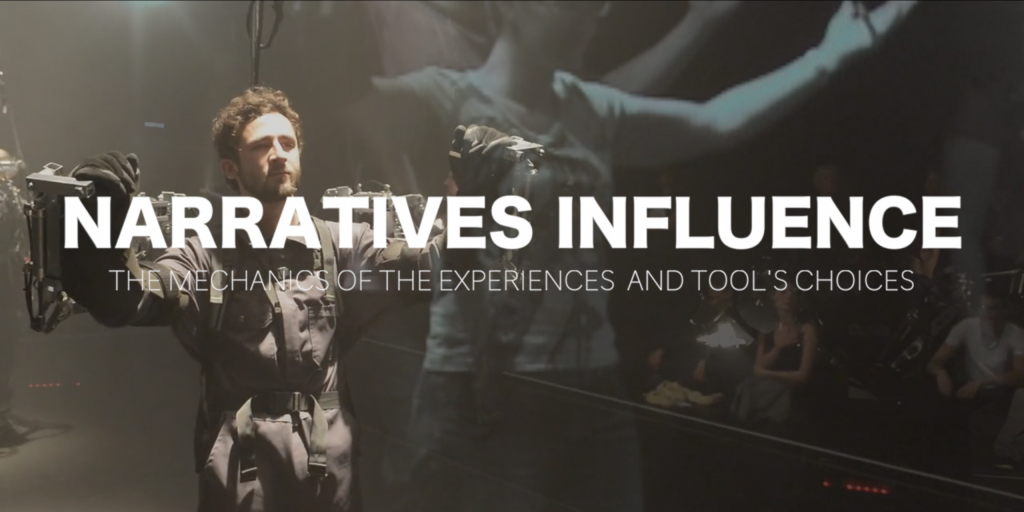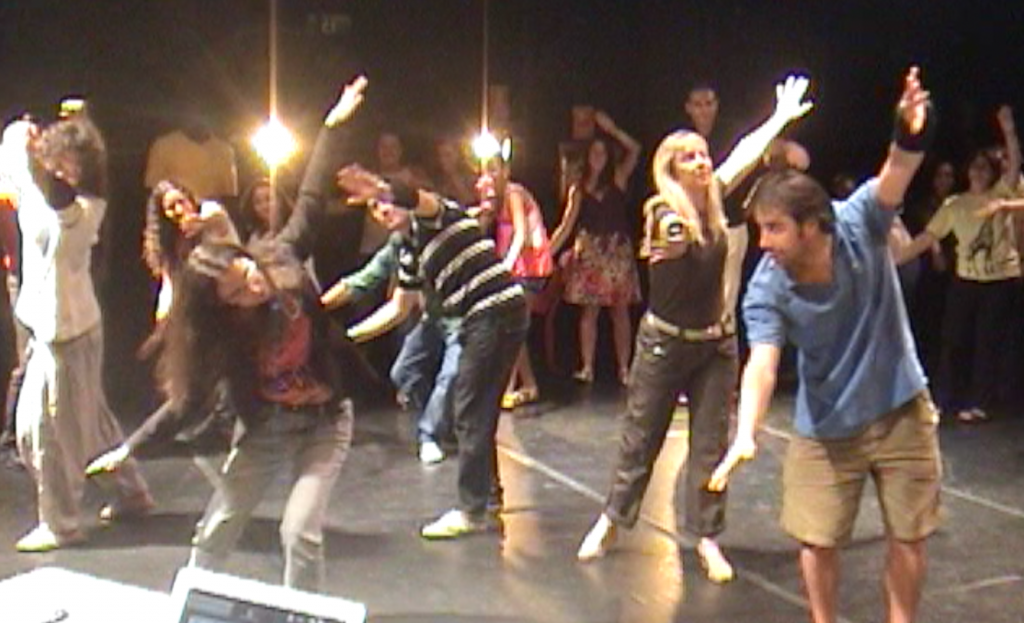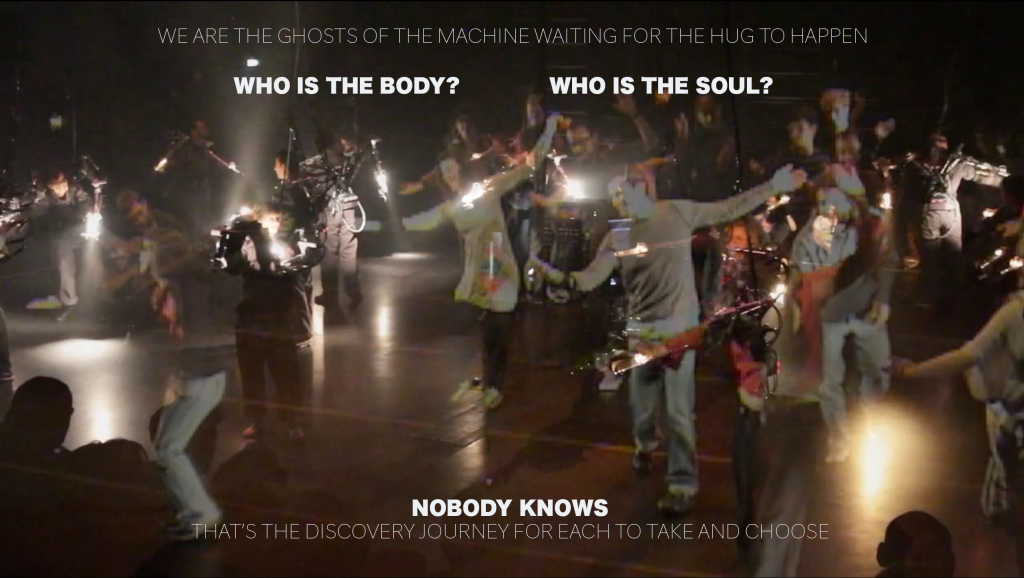WEARABLES: THE EROTICS OF MOVEMENT CONTROL SYSTEMS
This post explores the concept of the erotics of movement control systems through the analysis and comparison of two dance performances: ¿Por qué tenemos órganos pares y solo un corazón? by Paola Tognazzi (2009) and Inferno by Louis Philippe Demers & Bill Vorn (2015). These performances explore the intersection between politics of the sensorial and the erotics. Both performances integrate wearable technology, dance and body listening. The particularity of these performances is that are based on audience participation.
A deeper analysis of the narratives, tools, and strategies used to create these distinct experiences will reveal a key insight: to succeed in engaging the audience to participate the experience design needs to embody the erotics of movement control systems. The quality of stimulating mind and senses simultaneously to produce the energy for transformation (Lorde) In erotics is the energy that can connect mind and body and empower action.
¿POR QUÉ TENEMOS ÓRGANOS PARES Y SOLO UN CORAZÓN?
If your body could speak, what would it say?
Put on Wearable_SuperNow and dance your body will talk to you.
“¿Por qué tenemos órganos pares y solo un corazón?” is a participative performance that explores the theme of what do we know about the body, the body desire to be known and the need to dance in order to tame it from machine into human.
The process to build the performance began with the question: what is the body? After conducting interviews with a large sample of individuals, about how each body part function, answers like the brain functioning through electrical currents and the heart operating without our conscious control, suggest that the body can be seen as a machine. This raises an even more profound question: how can a machine be tamed to become human?
“In Terminator the TV show they say machines cannot dance, this is how one can recognize a terminator from a human. But Camaron, John’s Connor bodyguard took ballet lessons to learn to be human and one day John Connor saw her dancing in her room and we all though ohhh so sweet.”
The piece explore if dance can be the medium to transform a machine into a human.
Format and structure
The piece format is a hybrid between a workshop and an interactive installation, featuring the Wearable_SuperNow, accelerometer sensors embedded in wearable bracelets that allow to control sound tempo with movements.
The performance starts with the question: “If your body could speak, what would it say?” The audience answers are recorded directly in the wearable system. It then continue with a trivia questions game of specific questions relating body parts. It’s at this point we realize how little we know about our body. Participants are then invited to wear the sensor and copy the author dancing. The final collective dance initiates a dialogue with their bodies and immerse the audience in an intimate soundscape that speaks from within, reflecting upon the erotics of body movement control and the desire for true connection.
INFERNO
Inferno is a participative robotic performance project inspired by the concept of control and the representation of hell.
“From Dante’s Circles of Hell to theme parks such as Haw Par Villa’s Ten Courts of Hell, passing by Joe “the Mechanical Boy”, bodies are handed to eternal and external forces controlling and afflicting them. Those punishments and external powers, found in the depiction of numerous flavors of hell, suggests an infinite and mundane control loop under which the body will be forced to move endlessly. In Inferno, the “circles of hell” concept is a framework, a theme under which the different parts of the performance are regrouped.
The specificity of this performance resides in the situation where the machines involved in the performance are retrofitted on the body of raptured audience members cum performers. A select group of the public therefore become an active part of the performance, giving a radical instance of immersive and participative experiences. Shifting the exoskeleton’s command from the authors, to the computer, to the audience and to the performers, Inferno questions the nature of control – either machinic or human, either coerced or voluntary – where either utopian or dystopian futures radiate, both real and fictional. (Demers, 2015).”
SIMILARITIES
Both are collective dance performances based on narratives of control
Both apply:
• Audience participation
• Wearable interfaces
• Instructions of dancing sequences
Both deal with:
• Matters of trust and seduction to stimulate the audience to listen, focus and participate/act
In Why do we have organs in pair and only one heart? the audience is asked to put on the interactive system Wearable_SuperNow and then invited to follow the artist dancing.
In Inferno, Louis-Philippe Demers & Bill Vorn ask the audience to wear a robotic exoskeleton that will move their bodies according a preprogrammed choreographic sequence.
Ultimately, both play with the erotics of movement control systems and can be experienced as hell or paradise depending on subjective needs and tastes.
DIFFERENCES: NARRATIVES OF PERFORMANCE CONTROL, ROBOTS VERSUS SENSING MACHINES
Both are scripted narrative but the first one within an interactive tool that allows diversion, the second one within a programmed system, that allows no diversion.
In Why do we have organs in pairs and only one heart? the audience has the control over the performance and the interactive wearable. They can control their bodies performances and travel through the whole space.
In Inferno participants are moved by the robotic exoskeletons, they only receive the information and have no control over the dance performance. In addition they can only move within the wire (leash) circumscribed area.
While Demers through the robotic system conveys that the nature of control is either voluntary or coerced, Tognazzi through the interactive system shows that the nature of control is either aware or unaware.
THE POWER OF EROTICS: TRANSFORMING VULNERABILITIES IN SUPERPOWERS
In these performances technology is used to materialize vulnerabilities and by doing so transforms them in strengths and super powers.
Inferno materializes the sense of strength and invulnerability that came from the lack of responsibility when acting as pre programmed robots, while why do we have organs in pairs and only one heart? materializes the sense of fragility and vulnerability coming from the responsibility of being interactive sensing systems.
HOW CAN A MACHINE BE TAMED TO BECOME HUMAN?
Although the narratives of the two performances are different both conclude what AI and neuroscientists have currently discovered: the reason of brains is not to think but to control movement, the reason of dance is to make us humans.
WHEN THE TWO PERFORMANCES MET AND MELT TOGETHER
When superimposing the two pieces this moment happened. The participants in Tame Me gently approaching the ones in Inferno, perhaps attracted by the little lights shining on their arms, to hug them. In a way in this image, we can see the two performances core: reflection of beings split in two, mind and body, wondering like ghosts looking to reunite.
DATA TECHNOLOGY AND THE INTERSECTION BETWEEN POLITICS OF THE SENSORIAL AND THE EROTICS
In contrast to human perception, inherently biased and continuously shaped, whether consciously or unconsciously, by fleeting narratives, data technology per se is information, an intangible essence neither inherently good nor bad. However, information when applied, can transform into a material form that is both tangible and subject to manipulation.
When Tognazzi developed Wearable_SuperNow, in 2007, data technology was portrayed as a democratic medium that could free and connect us. Yet when Louis Philippe Demers made Inferno in 2015, the darker application of data technology as a tool for coercive control systems was noted.
CONCLUSION
In conclusion, while narratives define our realities, it is our bodies that bear the weight of the truths and untruths these stories carry. It’s in this realm of physical truth that we find our most profound lessons.”I’m going to teach you” said gently the wearable caressing her forehead. Today we dream of a wearable that doesn’t just inform, but guides through touch – a device that teaches with the softness and intimacy of a caress, bridging the gap between narrative and physical experience, between the stories we tell and the truths our bodies know.
“if only my body could endure the misery” ( From Lisa Caruso lyrics)
REFERENCES: “The Sarah Connor chronicle and Uncanny Valley”
In Uncanny Valley, Stefan Kaegi explores humans controversy between the desire to be in control and the desire for the illusion of being free from the responsibility of control by acting like machines.
Uncanny Valley – english documentation (Stefan Kaegi) from Rimini Protokoll on Vimeo.
Both the TV show reference to Terminators and the play Uncanny Valley examine the relationship between humans and machines, exploring the boundaries between the two. While Terminators are portrayed as machines, they possess a human quality in their ability to appreciate dance and art, blurring the lines between human and machine.
Similarly, Uncanny Valley examines the human desire for control and the idea of relinquishing that control by acting like machines. This raises questions about what it means to be human, as well as the complex relationship between humans and machines. Both references suggest that the line between human and machine is not always clear-cut and that there may be more overlap than we initially realize.






